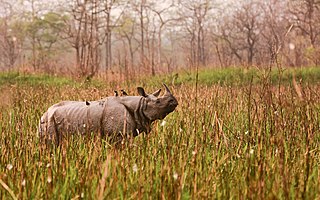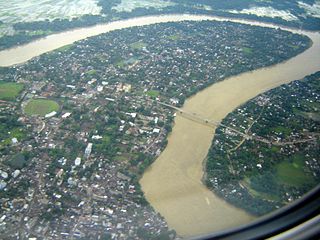
Assam is a state in northeastern India, south of the eastern Himalayas along the Brahmaputra and Barak River valleys. Assam covers an area of 78,438 km2 (30,285 sq mi). The state is bordered by Bhutan and Arunachal Pradesh to the north; Nagaland and Manipur to the east; Meghalaya, Tripura, Mizoram and Bangladesh to the south; and West Bengal to the west via the Siliguri Corridor, a 22 kilometres (14 mi) wide strip of land that connects the state to the rest of India. Assamese and Bodo are the official languages of Assam, while Bengali is official in the Barak Valley.

The United Liberation Front of Asom (ULFA) is an armed separatist organisation operating in the Northeast Indian state of Assam. It seeks to establish an independent sovereign nation state of Assam for the indigenous Assamese people through an armed struggle in the Assam conflict. The Government of India banned the organisation in 1990 citing it as a terrorist organisation, while the United States Department of State lists it under "other groups of concern."

Assam tea is a black tea named after the region of its production, Assam, India. It is manufactured specifically from the plant Camellia sinensis var. assamica (Masters). The Assam tea plant is indigenous to Assam—initial efforts to plant the Chinese varieties in Assam soil did not succeed. Assam tea is now mostly grown at or near sea level and is known for its body, briskness, malty flavour, and strong, bright colour. Assam teas, or blends containing Assam, are often sold as "breakfast" teas. For instance, Irish breakfast tea, a maltier and stronger breakfast tea, consists of small-sized Assam tea leaves.

The National Democratic Front of Boroland (NDFB) was an armed separatist outfit which sought to obtain a sovereign Boroland for the Bodo people. It is designated as a terrorist organisation by the Government of India.

Insurgency in Northeast India involves multiple armed separatist factions operating in some of India's northeastern states, which are connected to the rest of India by the Siliguri Corridor, a strip of land as narrow as 14.29 miles (23.00 km) wide.

Nagaon[nɔgaʊ zila] is an administrative district in the Indian state of Assam. At the time of the 2011 census it was the most populous district in Assam, before Hojai district was split from it in 2016.

Terrorism in India, according to the Home Ministry, poses a significant threat to the people of India. Compared to other countries, India faces a wide range of terror groups. Terrorism found in India includes Islamic terrorism, separatist terrorism, and left wing terrorism India is one of the countries most impacted by terrorism.

The Barak River flows 900 kilometres (560 mi) through the states of Manipur, Nagaland, Mizoram and Assam in India. Further it enters Bangladesh where it is known by the name of the Surma and the Kushiyara and later called the Meghna before receiving the combined flow of the Ganga and the Brahmaputra. It flows into the Bay of Bengal via Bangladesh. Of its length 524 km (326 mi) is in India, 31 km (19 mi) on the Indo–Bangladesh border and the rest is in Bangladesh. The upper part of its navigable part is in India — 121 km (75 mi) between Lakhipur and Bhanga, declared as National Waterway 6, (NW-6) since the year 2016. It drains a basin of 52,000 km2 (20,000 sq mi), of which 41,723 km2 (16,109 sq mi) lies in India, 1.38% (rounded) of the country. The water and banks host or are visited by a wide variety of flora and fauna.
The 1950 Assam–Tibet earthquake, also known as the Assam earthquake, occurred on 15 August and had a moment magnitude of 8.6. The epicentre was located in the Mishmi Hills in India, known in Chinese as the Qilinggong Mountains (祁灵公山), south of the Kangri Karpo and just east of the Himalayas in the North-East Frontier Agency part of Assam, India. This area, south of the McMahon Line and now known as Arunachal Pradesh, is today disputed between China and India. It is the strongest earthquake ever recorded on land.
Ethnic relations in India have historically been complex. India is ethnically diverse, with more than 2,000 different ethnic groups. There is also significant diversity within regions, and almost every province has its own distinct mixture of ethnicities, traditions, and culture. Throughout the history of India, ethnic relations have been both positive and negative.

Colonial Assam (1826–1947) refers to the period of History of Assam between the signing of the Treaty of Yandabo and Independence of India when Assam was under the British colonial rule. The political institutions and social relations that were established or severed during this period continue to have a direct effect on contemporary events. The legislature and political alignments that evolved by the end of the British rule continued in the post Independence period. The immigration of farmers from East Bengal and tea plantation workers from Central India continue to affect contemporary politics, most notably that which led to the Assam Movement and its aftermath.

The 2009 Assam serial blasts occurred on 6 April 2009 in the Maligaon and Dhekiajuli areas of the Assamese capital Guwahati on the eve of the Assamese Rajya Sabha MP and Indian Prime Minister's visit to address poll rallies. It also came during the campaigning phase of the 2009 Indian general election.

Muslim United Liberation Tigers of Assam(MULTA) is an Islamist extremist organization founded around 1996 in the eastern Indian state of Assam by mostly Bangladeshi-origin Muslims and indigenous Muslims in Assam. The South Asia Terrorism Portal (satp.org) describes it as part of the All Muslim United Liberation Forum of Assam(AMULFA), and that Muslim United Liberation Front of Assam(MULFA) is a sister organization under the AMULFA umbrella.

Assam separatist movements refers to a series of multiple insurgent and separatist movements that are or have been operating the in Northeast Indian state of Assam. The conflict started in the 1970s following tension between the native indigenous Assamese people and the Indian government over alleged neglect, political, social, cultural, economic issues and increased levels of illegal immigration from Bangladesh. The conflict has resulted in the deaths of 12,000 United Liberation Front of Assam (ULFA) militants and 18,000 others.
Kakopathar killings or the Kakopathar massacre took place in Assam during 2006 when the Indian army opened fire at peaceful protesters at Kakopathar in Assam, killing at least 10 people.

From the night of 1 May 2014 until the early morning hours of 3 May a series of attacks occurred on the Bengali Muslims in Assam, a north-eastern state of India. The perpetrator is unknown, but is suspected to be the National Democratic Front of Bodoland's Songbijit faction. Speculated to be revenge for not voting for the National Democratic Front in the Lok Sabha elections, the death toll reached 32.
In December 2014, a series of attacks by militants resulted in the deaths of more than 76 people in India. The attacks took place in the Chirang, Sonitpur and Kokrajhar districts on 23 December 2014. They have been attributed to the Songbijit faction of the National Democratic Front of Bodoland: NDFB(S).

Islam is the second largest religion in Assam. The Muslim population was approximately 13.61 million, constituting over 38.03% of the total population of the state as of 2021 year estimation, making Assam the second-largest Muslim-populated state in the country after Kashmir. Reaching the region in the 13th century, Islam is the fastest-growing religion in Assam. Muslims are a majority in almost thirteen districts of Assam and highly concentrated in four districts.
The Brahmaputra floods refers to a catastrophic flood event that occurred in 2012 along the Brahmaputra River and its tributaries, as well as in subsequent years.
Anti-Bengali sentiment in India comprises negative attitudes and views on Bengalis in India. Though Bengalis have lived in different parts of India for centuries, they are subject to widespread discrimination, specially by the people from the North and North-east India. This can be either by any other community or in any particular place, due to reasons like inhabitation, discriminating sentiments, political reasons, Government actions, migration issue, anti-Bangladeshi sentiment etc. The discriminative condition of Bengalis can be traced from Khoirabari massacre, Nellie massacre,Silapathar massacre, North Kamrup massacre,Goreswar massacre,Bongal Kheda etc. This has led to Bengali sub-nationalism in India as a form of protest and formation of many pro-Bengali organisations in India.












